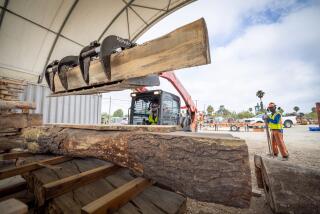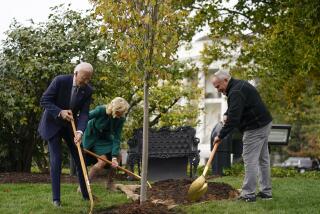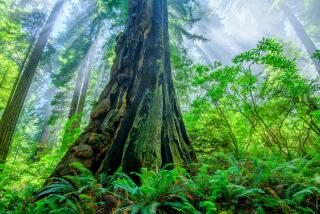Super Forests Getting Start in Labs of U.S. Lumber Giants
- Share via
FEDERAL WAY, Wash. — The little green, spiky balls of fluff and the warty, many-pronged branchlings on plastic dishes in the Weyerhaeuser Co. laboratory resemble little more than biological figments of some scientist’s imagination.
Though Mother Nature regulates the form, they are that. But although born of imagination, they are also a start on the commercial forests of tomorrow.
The tissue cultures from Douglas fir, lined up row after row beneath purplish Grolux lamps in a controlled-atmosphere room, are part of the attempt by scientists to use advances in biotechnology to make better trees.
Super-productivity has been achieved in vegetables and grains, and scientists believe similar results can be obtained with trees. However, unlike crops produced in just months, it will take a great deal of time to tell what can be achieved with trees.
“It remains to be seen, but it seems feasible to double or triple the productivity of forest lands before reaching the biological limits,” said Pat Trotter of Weyerhaeuser’s technology center, south of Seattle. “When you’re going to see that . . . I’m not going to predict.”
Testing Necessary
Bob Campbell, a research geneticist with the U.S. Forest Service’s Forest Sciences Laboratory in Corvallis, Ore., said extensive testing would be necessary to make sure the offspring of a biotechnology process would succeed.
“If you really change the genotype . . . we’re talking 50 years or something like that,” he said.
Trotter, who keeps track of biotechnology developments for Weyerhaeuser, the biggest wood products company in the country with 6 million acres in trees, said the company has already achieved good results through selective breeding.
Since the 1950s Weyerhaeuser has improved the output of its loblolly pine forests in the South and its Douglas fir forests in the Northwest by at least 25%, he said. A 50% gain will come in the next generation or two of trees, he said.
Other timber companies are making similar gains.
Besides productivity, such gains also raise the possibility of setting aside more publicly owned lands for wilderness and recreation uses, although scientists indicate they will happily leave such hot-potato questions up to politicians.
“That’s going to be up to people other than biologists,” said David Karnosky, professor of forestry at Michigan Technological University at Houghton on Michigan’s Upper Peninsula.
Although breeding has successfully provided faster-growing, higher-quality trees, many breakthroughs for tomorrow’s trees are coming in laboratories.
Cloning, to produce trees that are exactly the same, is a snap for many hardwood trees that send sprouts out from cut stumps. But cloning is also being achieved in conifer species: softwoods such as pines and firs that do not have natural cloning abilities but are commercially valuable.
That is accomplished by tissue culture and by embryogenesis: making embryos out of masses of cells. Also, scientists are working on introducing genes into trees to perform specific functions.
An ideal result as envisioned by many scientists is forests of fast-growing, high-quality trees of different species that carry genes for specific purposes, including resistance to herbicides, diseases and insects.
A forest for saw logs might specify a pine or fir of exceptional strength and straightness. In the South, where insects in loblolly pine are a problem, an in-bred gene that wards off insects might be desired.
A plantation destined for use in paper might be a fast-growing poplar exceptionally light in color and with more cellulose and less lignin, a necessary element to hold the tree together, but difficult to remove.
Crown Zellerbach experimental plantations of cross-bred cottonwood, a variety of poplar, are producing trees for paper in what might be as little as a six-year rotation. There is a possibility farmlands will turn from annual crops to the cultivation of cottonwoods, for paper pulp and possibly fuels.
Evolving Science
Scientists are also relishing the romance--albeit slow-moving--of letting the evolving science point to future uses and capabilities of wood from forests.
“We are in the very early stage of domestication of trees,” said Reinhard Stettler, a geneticist in the College of Forest Resources at the University of Washington. “ . . . There are bound to be all sorts of products and byproducts that we will put our finger on in later years.”
Forests will become more and more important as renewable resources, said Don Durzan of the University of California, Davis, a leading scientist in trying to establish plantlets through embryogenesis.
Fibers, fuel, construction, feed for livestock and exploitation of medicinal values are all present and future uses of trees, he said, with other uses unknown--but almost assuredly to be found.
“I don’t know what the products for this are going to be down the line,” he said, noting that scientists have been working for 25 years on forestry at the test-tube level.
Another benefit science offers, Durzan said, is the possibility of rebuilding forests in the eastern United States from largely inferior trees that remain after hundreds of years of exploitation and disease.
‘Can Get Plants Back’
“We now have the potential to add new genetic information into forestry cells, and once we can do that, we can get plants back,” he said.
And, he said, such things as acid rain may require some changes to be made to ensure that there are forests in the future.
“We’re going to have to put back a lot of trees, and we will need to find trees that can coexist with man,” he said.
Scientists also caution, however, that they can only tinker so much with Mother Nature.
There will never be a single “supertree,” said Roy Stonecypher, a geneticist at Weyerhaeuser’s research tree farm at Centralia, Wash., because of the need for genetic diversity in trees.
A diverse genetic makeup in trees, combining various qualities, might keep the most desired trait from reaching its greatest potential. However, diversity also ensures that a tree will have traits necessary to reach an age where it can be logged and utilized. For example, a tree that grows super-fast could end up being weak, and succumbing to a windstorm at 20 years of age, long before it could be used.
There have been some developments that have been virtually dazzling. Durzan said he has successfully inserted into pine and fir cells the gene that causes a firefly to light up.
It was a remarkable demonstration to show that foreign genes can be put into a tree’s cell.
Recent Scientific Effort
Only recently has science taken a hand in trying to develop, on a wide scale, a better tree in the United States.
Breeding of commercially valuable forest trees began in the 1950s, principally with loblolly pine in the South and Douglas fir in the Northwest, and it remains the primary method of improving forest stands. Like breeding in animals, it consists of crossing superior trees to produce even more superior offspring.
Trotter said each generation has averaged about a 10% to 12% improvement over the parent trees.
Test tube technologies will build on breeding, rather than replace it, and include:
- Tissue culture--also called micropropagation and organogenesis--uses organized tissues to produce multiple copies of a tree. Although many species produce clones by sprouting, it usually does not occur in the commercially valuable conifers, including pines and firs.
Karnosky, who has been working with micropropagation of larches, said the process, which requires a lot of handling, is too expensive and not dependable enough now to supply plantlings for whole forests in the United States. However, he said, New Zealand has been a leader in exploring tissue culture and is using the process to reforest areas in Monterey pine, an exotic imported from California several decades ago.
Successful for Weyerhaeuser
Tissue culture is also being used successfully by Weyerhaeuser and other companies that sell ornamental plants in a market with higher, and more immediate, returns, Trotter said.
- Embryogenesis from somatic, or established, cells holds the promise of deriving unlimited, identical plantlings from a superior tree. In embryogenesis, cells are allowed to grow in a culture until they start organizing into an embryo, a “seed.”
Although scientists have yet to derive a plant from the process, Trotter said it is just a matter of time. The promise, he said, is that costs of cloning could be low enough for use in generating forests, which take 45 years to reach maturity.
“We’re now very close to developing a process of getting embryos from old, mature trees,” Durzan said, noting a forester could have his pick in a forest of Coast Redwoods in northern California, or elsewhere.
“There is nothing like going to the showroom in the forest and saying, ‘I want that tree,’ ” he said.
Calendar Remains a Factor
Even when tissue culturing and embryogenesis are practical, scientists will still be battling the calendar. It will take at least six years of growth and testing to assure that the test-tube result is worthy of planting over large areas, Trotter said.
And, once clones are achieved, they still must be crossed sexually with other clones to assure a varied genetic makeup, Stonecypher noted.
The tissues being born in Douglas firs in Weyerhaeuser’s lab will eventually be placed at the company’s research tree farm in Centralia, each carefully measured and watched over.
Although they are special now, they will someday simply be among the first of a new generation of trees to be harvested and sent off to the mill.
“Eventually, they will be lost in the shuffle,” Trotter said.






